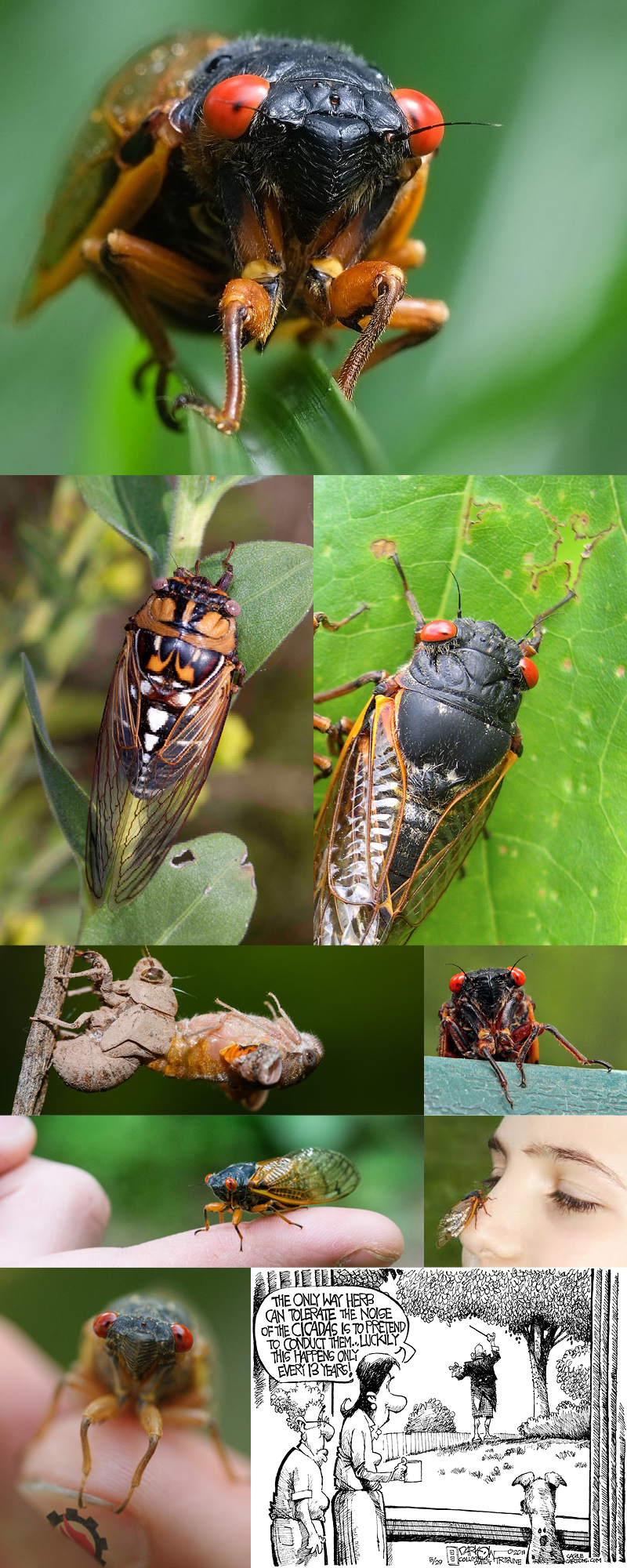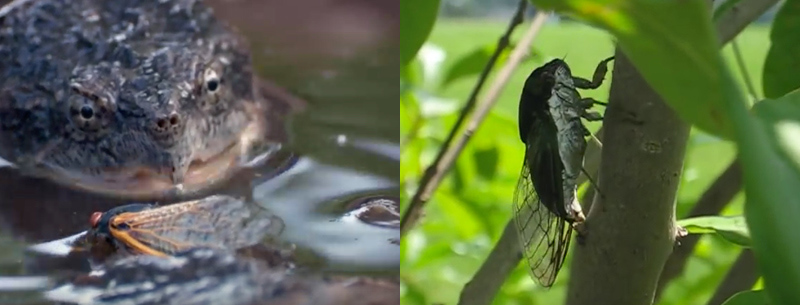Buzzzzzzzzzz

The periodic Cicada. Read on… And check out the videos below.
It’s the “dog days” of summer here in NE Ohio and I’m lovin’ it. (bonus trivia: the ancient Romans called the hottest, most humid days of summer “diēs caniculārēs” or “dog days.” The name came about because they associated the hottest days of summer with the star Sirius, known as the “Dog Star” because it was the brightest star in the constellation Canis Major (Large Dog). When I was a kid, I tried to get everything in these last few weeks before school started. Football practice (two-a-days) was a rite of hubris passage. The days are sticky, and the nights are starting to cool down with just the slightest dew on the lawns in the morning. This time of year, one of my favorite things to do is kick back in a lounge chair and listen to the songs of the cicadas. I love the way their piercing sound cuts through the daytime air, reminding me to stay outside and enjoy the weather as long as possible. Now Jackie on the other hand can’t fall asleep to their “beautiful” music! I realized I really don’t know much about the cicadas (other than they buzz and are pretty ugly looking), so I went to my favorite Wikipedia to learn more. Enjoy the info, and the next time someone remarks about them, you can be the “cliff klavin” in the group who says …. “did you know, the cicadas…”
- The cicadas are a superfamily, the Cicadoidea of insects in the order Hemiptera (true bugs). They are in a suborder with smaller jumping bugs such as leafhoppers and froghoppers, with more than 3,000 species described from around the world.
- Cicadas have prominent eyes set wide apart, short antennae, and membranous front wings. They also have three small ocelli located on the top of the head in a triangle between the two large eyes, with mouthparts that form a long sharp rostrum that they insert into plants to feed.
- The “singing” of male cicadas is not stridulation such as many familiar species of insects produce, crickets, for example. They have an exceptionally loud song, produced by vibrating drum like tymbals rapidly. Comparatively large insects, they are conspicuous by the courtship calls of the males. The male abdomen is largely hollow, and acts as a sound box. By rapidly vibrating these membranes, a cicada combines the clicks into apparently continuous notes, and enlarged chambers derived from the tracheae serve as resonance chambers with which it amplifies the sound. The cicada also modulates the song by positioning its abdomen toward or away from the substrate. Partly by the pattern in which it combines the clicks, each species produces its own distinctive mating songs and acoustic signals, ensuring that the song attracts only appropriate mates.
- The adult insect, known as an imago, is 1-2 inches in total length in most species, with a wingspan of about 3-4 inches. The largest species is the Malaysian emperor cicada with a wingspan of up to about 8 inches (yikes!).
- The surface of the forewing is super-hydrophobic; it is covered with minute waxy cones, blunt spikes that create a water-repellent film. Rain rolls across the surface, removing dirt in the process. In the absence of rain, dew condenses on the wings. When the droplets coalesce, they leap several millimetres into the air, which also serves to clean the wings.
- Cicadas typically live in trees, feeding on watery sap from xylem tissue and laying their eggs in a slit in the bark. Most cicadas are cryptic, singing at night to avoid predators. The annual cicadas are species that emerge every year. Though they have life cycles that can vary from one to nine or more years as underground larvae, their emergence above ground as adults is not synchronized so some appear every year. The periodic cicadas spend most of their lives as underground nymphs, emerging only after 13 or 17 years, which may reduce losses by starving their predators and eventually emerging in huge numbers that overwhelm and satiate any remaining predators.
- In some species of cicada, the males remain in one location and call to attract females. Sometimes several males aggregate and call in chorus. In other species, the males move from place to place, usually with quieter calls while searching for females.
- For the human ear, it is often difficult to tell precisely where a cicada song originates. The pitch is nearly constant, the sound is continuous to the human ear, and cicadas sing in scattered groups. In addition to the mating song, many species have a distinct distress call, usually a broken and erratic sound emitted by the insect when seized or panicked. Some species also have courtship songs, generally quieter, and produced after a female has been drawn to the calling song. Males also produce encounter calls, whether in courtship or to maintain personal space within choruses.
- Cicadas have been featured in literature since the time of Homer’s Iliad, and as motifs in art from the Chinese Shang dynasty. They have been used in myths and folklore to represent carefree living and immortality. Cicadas are eaten in various countries, including China, where the nymphs are served deep-fried in Shandong cuisine.
- Cicadas are commonly eaten by birds and sometimes by squirrels, as well as bats, wasps, mantises, spiders and robber flies. In times of mass emergence of cicadas, various amphibians, fish, reptiles, mammals and birds change their foraging habits so as to benefit from the glut. Newly hatched nymphs may be eaten by ants, and nymphs living underground are preyed on by burrowing mammals like moles.
- Cicadas have been featured in literature since the time of Homer’s Iliad, and as motifs in decorative art from the Chinese Shang dynasty (1766–1122 BC.). They are described by Aristotle in his History of Animals and by Pliny the Elder in his Natural History; their mechanism of sound production is mentioned by Hesiod in his poem Works and Days “when the Skolymus flowers, and the tuneful Tettix sitting on his tree in the weary summer season pours forth from under his wings his shrill song”.
- Cicadas have been used as money, in folk medicine, to forecast the weather, to provide song (in China), and in folklore and myths around the world. In France, the cicada represents the folklore of Provence and the Mediterranean cities.
- In the Chinese tradition, the cicada symbolizes rebirth and immortality. In Japan, the cicada is associated with the summer season; the song of Meimuna opalifera, called “tsuku-tsuku boshi”, is said to indicate the end of summer, and it is called so because of its particular call.
- In the Homeric Hymn to Aphrodite, the goddess Aphrodite retells the legend of how Eos, the goddess of the dawn, requested Zeus to let her lover Tithonus live forever as an immortal. Zeus granted her request, but, because Eos forgot to ask him to also make Tithonus ageless, Tithonus never died, but he did grow old. Eventually, he became so tiny and shriveled that he turned into the first cicada.
- Cicadas were eaten in Ancient Greece, and are consumed today in China, both as adults and (more often) as nymphs, in Malaysia, Burma, Latin America, North America, and central Africa female cicadas are prized for being meatier. Shells of cicadas are employed in traditional Chinese medicines, and some are fried and eaten as a protein source (crunch, eeeewww).
- Cicadas are not major agricultural pests but in some outbreak years, trees may be overwhelmed by the sheer numbers of females laying their eggs in the shoots. Small trees may wilt, and larger trees may lose small branches. Cicadas sometimes cause damage to amenity shrubs and trees, mainly in the form of scarring left on tree branches where the females laid their eggs. Branches of young trees may die as a result.
INTERESTING CICADA VIDEOS

(left) A great BBC four minute Cicada docudrama.
(right) A close-up of a summer cicada making some noise by a guy in Franconia, PA. One minute.
COOL CICADA MUSIC VIDEOS

(left) Cicada Serenade by The Pheromones. A really fun music video.
(center) Hannah Gansen sings about a love affair seventeen years in the making.
(right) “I Ate A Cicada Today” An excerpt from a CD by the author, illustrator, songwriter, Jeff Crossan.



Leave a Reply
Want to join the discussion?Feel free to contribute!